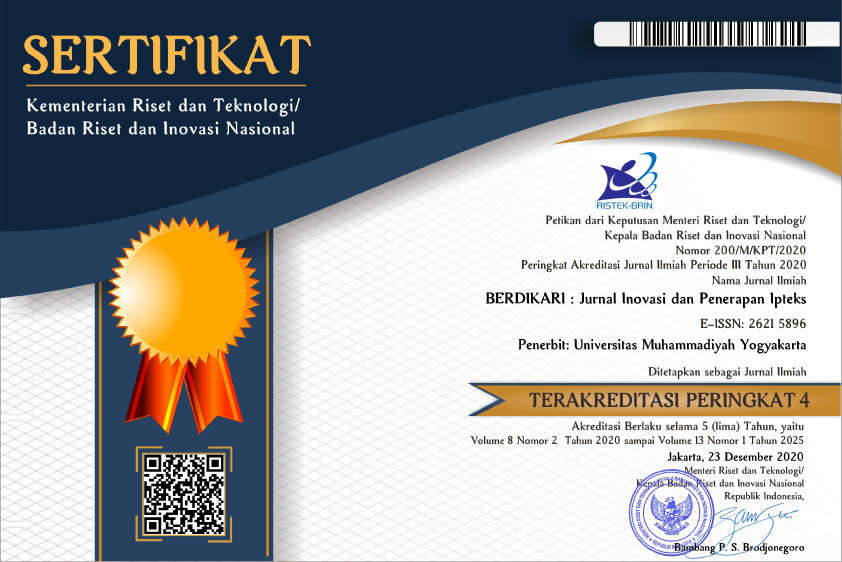Pendampingan Pasien Obesitas dan Diabetes Mellitus Era Pandemi Covid-19
DOI:
https://doi.org/10.18196/berdikari.v10i1.11113Keywords:
OSOF, DM, obesity, mentoringAbstract
This activity aims to provide community service with the One Student One Family (OSOF) scheme. The activity was carried out to improve the quality of patients with obesity and Diabetes mellitus (DM) in Family A (families with problems with non-communicable diseases or PTM) in Bantul, Yogyakarta during the Covid-19 pandemic. The methods used in this service are education, mentoring, monitoring, and evaluating consumption patterns, physical activity, measuring weight, and checking blood sugar levels. In addition, the commitment of patients and family members is initiated to achieve a good quality of life. The results of this service activity indicate that mentoring impacts improving the quality of life of patients in the form of improving diet, exercise habits/physical activity, weight loss of 1.1 kg in 2 weeks, and decreasing blood sugar levels by 116 mg/DL. In addition, there is a patient's commitment to implementing a healthy lifestyle vigorously in the long term to produce better results. Family members also expressed a commitment to continuously provide motivation, support, and an environment to improve the patient's quality of life. This proves that the OSOF program has succeeded in having a positive impact on the target.
References
Badan Penelitian dan Pengembangan Kesehatan (2013) ‘Riset Kesehatan Dasar (RISKESDAS) 2013’, Laporan Nasional 2013, pp. 1–384. doi: 1 Desember 2013.
Beleslin B, Cirić J, Zarković M, Vujović S, Trbojević B, D. M. (2007) ‘The effects of three-week fasting diet on blood pressure, lipid profile and glucoregulation in extremely obese patients’, Srp Arh Celok Lek, 135(7–8), pp. 440–6. doi: 10.2298/sarh0708440b. PMID: 17929537.
Chawla A, Chawla R, J. S. (2016) ‘Microvasular and macrovascular complications in diabetes mellitus: Distinct or continuum?’, Indian J Endocrinol Metab, Jul-Aug, 2(4), pp. 546–551. doi: doi: 10.4103/2230-8210.183480.
Finkler, E., Heymsfield, S. B. and St-Onge, M.-P. (2013) ‘Rate of weight loss can be predicted by patient characteristics and intervention strategies’, 112(1), pp. 75–80. doi: doi:10.1016/j.jada.2011.08.034.
Hruby, A. and Hu, F. B. (2016) ‘HHS Public Access’, 33(7), pp. 673–689. doi: 10.1007/s40273-014-0243-x.The.
Kemenkes RI (2018) Laporan Riskesdas DIY 2018. Jakarta, Indonesia: Badan Litbangkes Kemenkes RI.
Kemenkes RI (2019) ‘Prinsip Gizi Seimbang’. Available at: http://www.p2ptm.kemkes.go.id/infographic-p2ptm/obesitas/apa-saja-4-pilar-utama-dalam-prinsip-gizi-seimbang.
Kemenkes RI, B. L. (2018) Laporan Riskesdas 2018 Nasional. Jakarta, Indonesia.
Ng M, Fleming T, Robinson M, Thomson B, Graetz N, M. C. and Al, E. (no date) ‘Global, regional, and national prevalence of overweight and obesity in children and adults during 1980–2013: a systematic analysis for the Global Burden of Disease Study 2013’, The Lancet, 384(9945), pp. 766–78. Available at: https://www.sciencedirect.com/science/article/abs/pii/S0140673614604608.
Rise, M. B., Pellerud, A., Rygg, L. Ø. and Steinsbekk, A. (2013) ‘Making and Maintaining Lifestyle Changes after Participating in Group Based Type 2 Diabetes Self- Management Educations : A Qualitative Study’, 8(5), pp. 1–7. doi: 10.1371/journal.pone.0064009.
Russell, W. R., Baka, A., Björck, I., Delzenne, N., Gao, D., Griffiths, H. R., Hadjilucas, E., Juvonen, K., Lahtinen, S., Loon, L. Van, Mykkänen, H., Riccardi, G., Vinoy, S., Weickert, M. O., Russell, W. R., Baka, A., Björck, I., Delzenne, N., Gao, D., Griffiths, H. R., Hadjilucas, E., Juvonen, K., Lahtinen, S., Lansink, M., Van, L., Mykkänen, H., Riccardi, G., Vinoy, S., Weickert, M. O., Russell, W. R., Baka, A., Orck, I. B. J. and Delzenne, N. (2016) ‘Impact of Diet Composition on Blood Glucose Regulation Impact of Diet Composition on Blood Glucose Regulation’, 8398. doi: 10.1080/10408398.2013.792772.
Siswati, T., Kasjono, H. S. and Olfah, Y. (no date) ‘Yogyakarta Darurat Penyakit Tidak Menular ( PTM )’, Policy Brief, pp. 2–5. doi: 10.13140/RG.2.2.34773.04323.
WHO (no date a) ‘Diabetes’. Available at: https://www.who.int/health-topics/diabetes#tab=tab_1.
WHO (no date b) ‘Non Communicable Diseases’. Available at: https://www.who.int/news-room/fact-sheets/detail/noncommunicable-diseases.
WHO (no date c) ‘Obesity’. Available at: https://www.who.int/health-topics/obesity#tab=tab_2.
WHO (no date d) ‘Obesity and Overweight’. Available at: https://www.who.int/news-room/fact-sheets/detail/obesity-and-overweight.
Downloads
Published
Issue
Section
License
Copyright
Authors retain copyright and grant BERDIKARI Jurnal Inovasi dan Penerapan IPTEK the right of first publication with the work simultaneously licensed under an Attribution 4.0 International (CC BY 4.0) that allows others to remix, adapt and build upon the work with an acknowledgment of the work's authorship and of the initial publication in BERDIKARI Jurnal Inovasi dan Penerapan IPTEK.
Authors are permitted to copy and redistribute the journal's published version of the work (e.g., post it to an institutional repository or publish it in a book), with an acknowledgment of its initial publication in BERDIKARI Jurnal Inovasi dan Penerapan IPTEK
License
Articles published in the BERDIKARI Jurnal Inovasi dan Penerapan IPTEK) are licensed under an Attribution 4.0 International (CC BY 4.0) license. You are free to:
- Share — copy and redistribute the material in any medium or format.
- Adapt — remix, transform, and build upon the material for any purpose, even commercially.
This license is acceptable for Free Cultural Works. The licensor cannot revoke these freedoms as long as you follow the license terms. Under the following terms:
- Attribution — You must give appropriate credit, provide a link to the license, and indicate if changes were made. You may do so in any reasonable manner, but not in any way that suggests the licensor endorses you or your use.
- No additional restrictions — You may not apply legal terms or technological measures that legally restrict others from doing anything the license permits.




